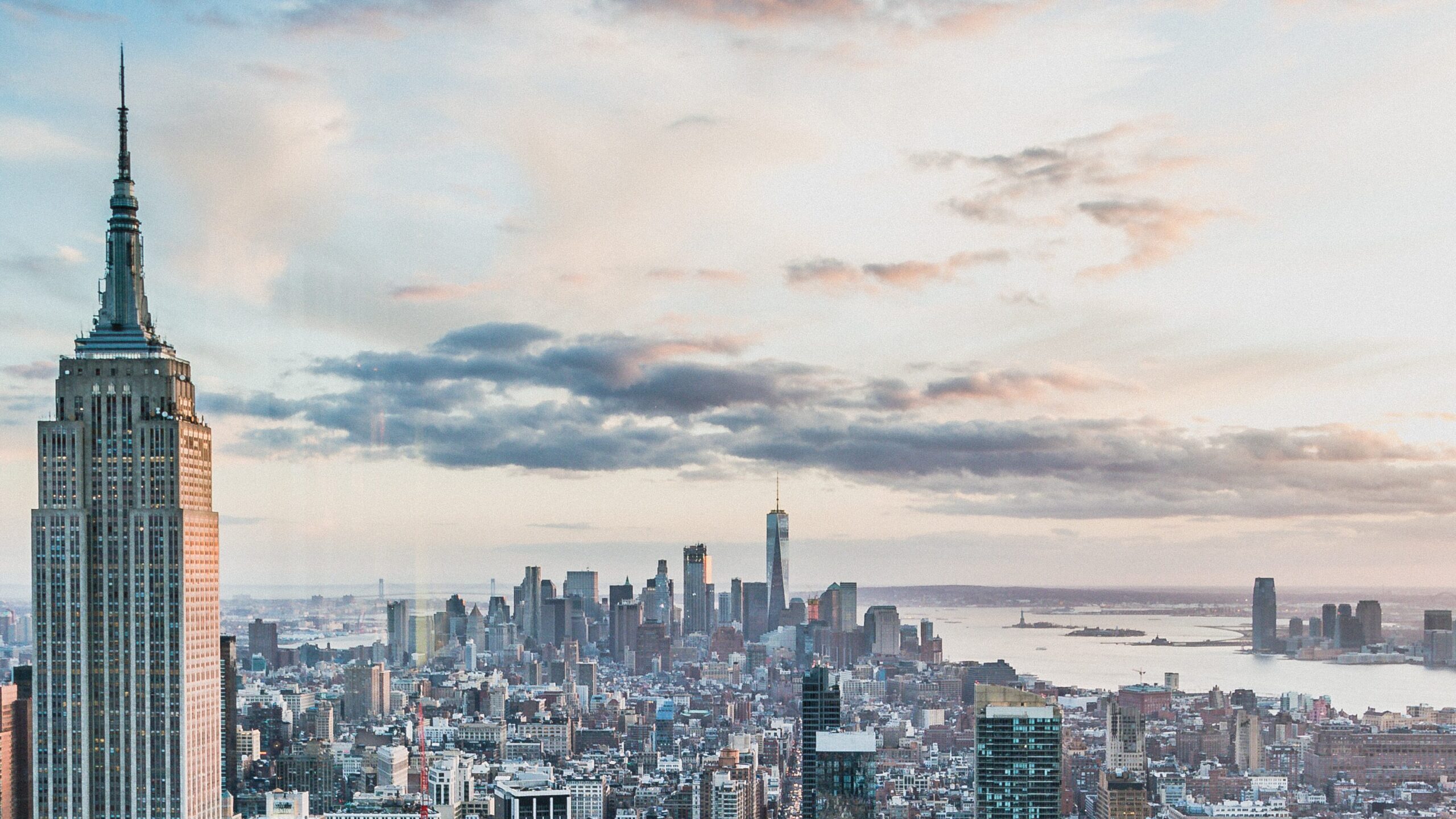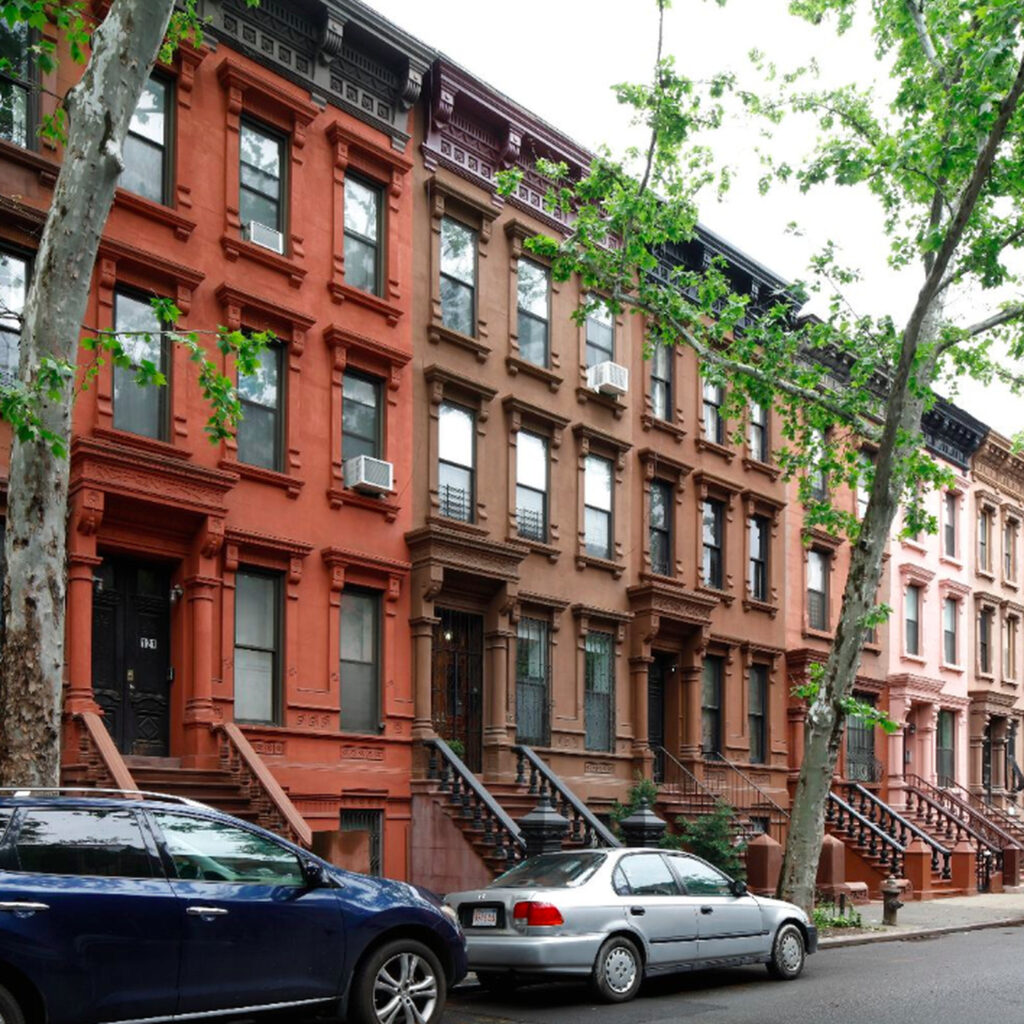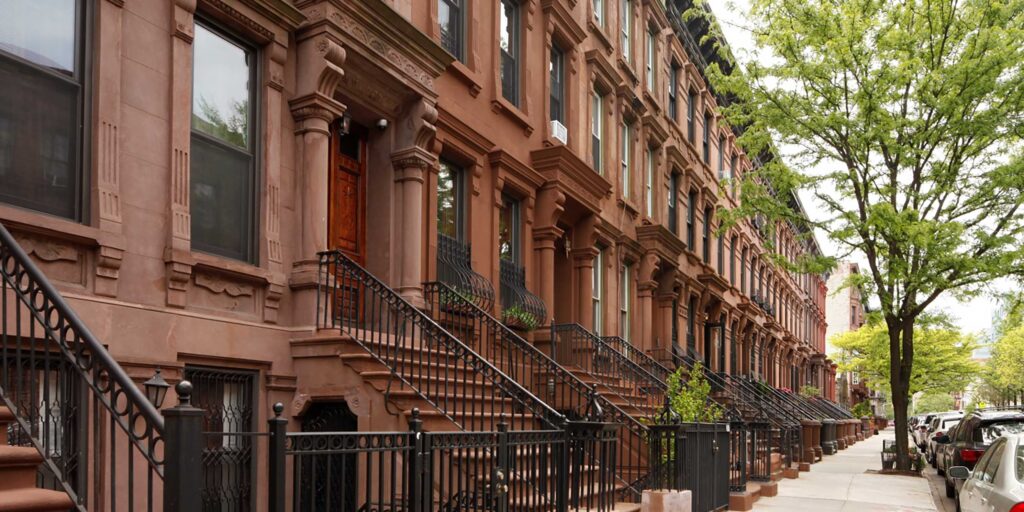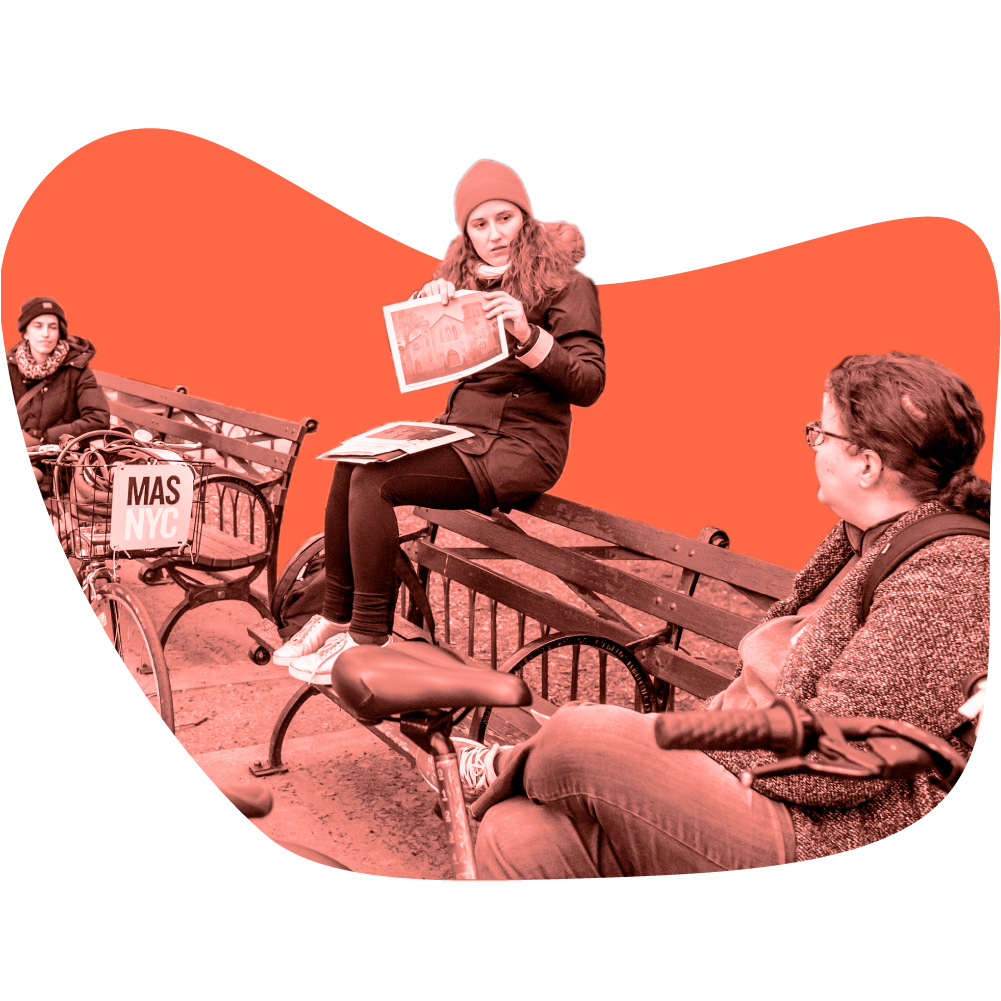
The Municipal Art Society of New York
Since 1893, the Municipal Art Society of New York (MAS) has lifted up the voices of the people in the debates that shape New York’s built environment, leading the way toward a more livable city from sidewalk to skyline. MAS has been the NYC organizer of Jane’s Walk since 2011, and what started as a handful of walks has since grown to include hundreds of walks and activities organized across the five boroughs and online. To learn more about Jane’s Walk NYC or to join the movement, contact [email protected] or visit www.mas.org/janes-walk-nyc.
Walk Stories
Walk stories are chronicles of moments, ideas, insights, and images from a Jane’s Walk, curated and submitted by local participants, walk leaders, and city organizers.
May 2022 – Central Harlem’s Little Known District
Walk Leader: Savona Bailey-McClain
Photographs by: Municipal Art Society, Harlem World Magazine, Curbed



The Central Harlem Historic District is a fairly new designation. It spotlights little-known Black history. Several Black charities like the Clubman’s Beneficial League and the Utopia Neighborhood Club found homes in this district. Many Black entertainers like James Reese Europe, of WWI fame, lived here. The district shows that a tight-knit community once lived and still lives in Central Harlem. They supported each other and made sure they could enjoy a rich, quality of life.
May 2016 – Bowne Street, My Street
Walk Leader: Jack Eichenbaum
Text by: Jack Eichenbaum
In celebration of the glorious life, legend, lore and legacy of Jane Jacobs a group set forth on Saturday morning, May 7, 2016, from the heart of what the Municipal Art Society has characterized as Historic Downtown Flushing, Queens, New York.
With our group Leader, JACK EICHENBAUM, at the helm, we quickly fleet footed past St. George’s Episcopal Church, unto Northern Boulevard and Main Street, the situs of the now infamous RKO KEITH’S THEATER, which has become a symbol of humanity’s unquenchable lust for money at the expense of history if not preservation, fully forward en route to Bowne Street, before attending to what is clearly now the elevation of form over function – FLUSHING HIGH SCHOOL, designated as a landmark by the New York City Landmarks Preservation Commission in 1991, where nearby rests the home of Lewis Latimer, the freed Black slave credited in 1881 with the “Process of Manufacturing Carbons, within the NYCHA.
“Latimer Gardens” complex, which former property is a member of the Historic House Trust and reflects an appreciation of what The Bible caveats: ‘…save what remains’ – thanks to an enlightened late 1980s community push to preserve when the Latimer House – now a Science Museum for Children – faced the developer’s wrecking ball. But I digress…
Cut to the chase: THE QUAKER MEETING HOUSE, THE KINGSLAND HOMESTEAD, BOWNE HOUSE (1661), THE HINDU TEMPLE SOCIETY OF NORTH AMERICA [in front of which John Cage in the 1970s situated “Waltz 22.3” – Waltzes for The Five Boroughs] – all
resounding highlights of this Jane’s Walk – one and all mere foreplay for what in modern American political history may soon become the hugest in Bowne Street’s real estate cache, namely ’41-10 Bowne Street’, a property once known as Kendall Hall.
Why you wonder.
Frederick Christ Trump, the New York-born Father, of the son, Donald H. Trump, the man who would become President, developed this Queens apartment house with his trademark lobby bird cages still in-tact. Interestingly this Father of the man who has revived the tag line – America First – is the very same person who in the middle of The Great Depression pioneered the concept of supermarkets with the ‘Trump Market’ [tag line: “Serve Yourself and Save”] – which became a mega hit. Curiously shortly after her birth on July 6, 1921, Anne Frances Robbins moved into a three story wooden house at 149-40 Roosevelt Avenue, Flushing, less than a two minute walk from the Trump Elder property. Ultimately that same individual – NANCY REAGAN – moved into The White House.
Will history repeat itself – will Flushing – that is widely viewed as the Home of Religious Freedom in America [THE FLUSHING REMONSTRANCE], as well as the chalice of the rights to free speech and assembly which were fought and ultimately vindicated thereat – yet again assume a singular historic American political connection? Specifically, will BOWNE STREET / MY STREET / be the conduit for a future President’s passage…
Stay tuned, it depends.
But Jack Eichenbaum, the man who named and claimed “Jane’s Walk”, surely has found his very personal connection to the street on which he lives: BowneStreet has magnificent oak trees nearby his residence [thanks to SamuelParsons who founded the well-known Parsons Nursery in 1838 – now the site of Flushing High School]. Eichenbaum incidentally is the topographic name for someone who lived near an oak tree, from Middle High German eiche ‘oak’ + boum ‘tree’. The streets that run parallel to Bowne Street until Kissena Park / Parsons Boulevard – which Park Samuel Parsons, Jr. designed – bear the names of their living plant legacy.
Name it, claim it.
– Francie Scanlon [who resides just off Bowne Street on Beech Avenue tributes Samuel Parsons who in 1847 brought back an oddity known as the European Weeping Beech in a small flowerpot that flourished as a WEEPING BEECH TREE just east of Bowne Street at another New York City landmark, the Kingsland Homestead].
May 2014 – A Walk Through East Brooklyn’s “Diamond in the Rough”
Walk Leader: Alonzo Jones Jr. and the Brownsville Community Justice Center
Text by: Stacey Anderson
Alonzo Jones Jr., 20 years old and born and raised in Brownsville, Brooklyn, organized and led this Jane’s Walk because he wanted to help overcome the tarnished image the media paints of his community. Although it covers less than two square miles, Brownsville appears frequently in the news: “#1 with bullets:, “murder capital of New York” and “where optimism feels out of reach” have been some recent headlines.
As Alonzo explains, “Leading the walk allowed me to share our history with other youth, so now, when they go out and talk about Brownsville, they can tell a different story.” He researched the walk thoroughly, by reading books and websites but mainly by talking to community elders, “because not only did they know the history, they had lived it.”
A man known as Uncle Roy provided him with a lot of information. “He has been an entrepreneur in the community for as long as I can remember. He could talk about the past, present and future of Brownsville because he sees it every day and has conversations with everyone who walks by. After I talked to him, I altered my route a lot. Initially, I was only going to take people to places I knew, but Uncle Roy made me want to dig deeper and discover some new places.”
The first stop along the two-hour route was the Stone Avenue branch of the Brooklyn Public Library, which just celebrated its 100th birthday. In 1914, Brownsville’s main library was so popular it became overcrowded, and the city opened this second branch dedicated to children’s books. It was the first children’s library in the world. Many walkers had not been aware of this fact, including a woman who lived just two blocks away and passed by the building every day.
May 2014 – Crown Heights: Where Change Is Happening
Walk Leaders: Lisa Schreibman and Michael Fagan
We called the walk “Crown Heights: Where Change Is Happening”. Seventy-three people showed up. So much for small group discussion, but boy were we happy we had two routes planned. In all honesty, we could have used a third. We started the walk by asking the group where they were from and why they had come. Nearly everyone who attended was from New York City, most from Brooklyn and the vast majority of people had arrived on foot. Those people who don’t live in Crown Heights mostly came for an introduction to the area. A lot of people from the neighborhood came because they wanted to see more of the stores. Residents who had lived there longest were interested in the new stores, the ones who were recent arrivals wanted to learn about the old ones. We threw out themes we had seen evolving in the past decade. The neighborhood had become whiter, richer and younger than when we had moved to it. There was also more housing, though less affordable housing. We asked the participants to think about those trends as we visited the various businesses and why it meant that places had opened or closed. Almost all the participants made it to the two hour mark of the walk. A third few stuck it out for the last half hour and a dozen people had drinks with us after the walk to keep the discussion going. For me, the most interesting take away was to realize how many people never stray from their comfort zones. Whether long-time residents or new transplants people expressed surprise and delight at some stores they had never realized existed despite walking past them regularly.
May 2014 – “Dumbo Transformed: The New Art/Tech Face of Brooklyn”
Walk Leader: Karen Zabarsky
One of the reasons people from all over the world are so attracted to New York City is that it never sits still. The streets flow with an ever-shifting urban dynamic between history and prospect, tradition and trend. I was inspired to set my Jane’s Walk on the cobblestone paths of Dumbo, Brooklyn – one of the City’s coolest neighborhoods – because this dynamic is visible everywhere you look. Here, on the shores of the historic East River, abandoned Civil War-era warehouses are being restored and re-used as tech office spaces and art galleries. Eighteenth century horse stables stand next to twenty-first century glass high-rises.
In leading my Jane’s Walk, I was delighted by the diversity of the audience, among them French tourists, decade-long Dumbo residents, a couple of Swedish professors and college students. We meandered through the neighborhood’s recently developed waterfront park and historic streets, and I noticed the crowd growing with interested passersby as we proceeded. Walkers stopped for photos by the river and snapshots of the famous Empire State Building view down Water Street.
Step by step, discussion spurred among the group about the changes being implemented in Dumbo. The diversity of the walkers fueled the dialogue further: international visitors were curious, students were engaged, and some locals expressed frustration. One walker argued that New York City should be in constant transition; another was concerned about residents’ ability to afford the neighborhood as its prestige grew.
In these final moments of discourse, I came to realize the beauty of Jane’s Walks as a public platform for conversation about the future of our cities. That spring New York day, everyone on the Jane’s Walk was able to ask: What do we want our streets to look like? How do we move forward while holding on to rich historic fabric? How do we maintain healthy, heterogeneous communities and public spaces as we progress? In true Brooklyn fashion, I closed my Jane’s Walk with an invitation to join me for a round of drinks at Olympia Wine Bar, where the conversation continued long into the night.
May 2014 – “Iron and Light: Exploring SoHo’s Cast Iron Architecture”
Walk Leader: Scott Francisco, Founder & Director, Pilot Projects Design Collective
Story by: Scott Francisco
Twenty-five New Yorkers and I spent a beautiful blustery spring afternoon weaving through the historic blocks that Jane Jacobs helped save from a Robert Moses wrecking ball between Prince and Canal streets. Looking upwards as we walked, we talked
history and industry, used magnets to test the metal, and even attempted a sand-casting (using wax instead of iron) on a windy Broome Street sidewalk.
Walking through SoHo today is a bizarre time warp. Wild-west facades meet industrial revolution tech, set off with the latest global fashion trends. Expansive storefront windows are working as well today as they were when innovative nineteenth century shopkeepers competed for visibility.
By the turn of the century, the invention of the elevator and the introduction of steel in construction led to the decline of cast iron architecture. As did concerns about cast iron’s strength in a building fire. SoHo plunged into a period of neglect as industry and commerce moved north into Midtown’s newly built skyscrapers. Once grand buildings were abandoned or used as unheated storehouses for scrap paper and the neighborhood became known as “Hell’s Hundred Acres” due constant fires. In the 1950s and ‘60s artists seeking low rent and light-filled open spaces for large art pieces helped save SoHo’s cast iron buildings from being razed, while Jane Jacobs staved off Robert Moses’ 10 lane freeway. In 1973 the “SoHo Cast Iron Historic District” was designated by the Landmarks Commission for protection in perpetuity.
Today SoHo has the highest concentration of cast iron buildings anywhere in the world. For better or for worse, throughout this neighborhood’s up and down seasons, the look and feel of cast iron architecture remains unique. Grab a magnet and come check it out.
May 2014 – “Taking it to the Streets: Jane Jacobs in Three Queens Plazas”
Walk Leader: Neighborhood Plaza Partnership
Story by: Micaela Birmingham
I recently went on a “Jane’s Walk” of three public plazas in Queens to celebrate the legacy of Jane Jacobs. On the tour, organized by the Neighborhood Plaza Partnership, I was reminded of an important voice in the dialog about public space – children. While the need for thriving parks, playgrounds and recreational facilities in every neighborhood cannot be understated, public plazas also play a unique role in the lives of children.
This was illustrated first hand while City Council Member Julissa Ferreras gave an inspiring talk to our group about turning her vision for Corona Plaza into reality. As she spoke, there was another important moment happening – behind the flower pots. With adults discussing the process of relocating bus stops and truck traffic, children in the plaza steps away, played a serious game of hide and seek. As one boy hid, his friend, the “seeker” covered his eyes and wildly counted down in Spanish: “Diez! Nueve! Oche! Siete!…” This spirited game demonstrated the uniqueness of a child’s perspective of a plaza. Experiencing the space from two or three feet from the ground, children can seamlessly transform a safe street of colorful, moveable chairs into a fantasy world where hiding in plain sight becomes the best hiding place ever.
The next stop at 78th Street Plaza in Jackson Heights, included a talk by Georgia Southworth of the Jackson Heights Green Alliance. Southworth began working with local parents in 2007 to provide more play space for neighborhood children. By successfully transforming 78th Street into a play street closed to car traffic, the Alliance has continued its advocacy resulting in a permanent public plaza. A local father described how the 78th Street Plaza had become his daughter’s preferred location for practicing the pogo stick.
As a distinctive toy on the playground circuit, the pogo stick has garnered quite a following in this plaza. He explained: “Last Saturday my daughter counted 1000 consecutive jumps on the stick. That is her record and she is very proud.” He described that over the course of a weekend, his daughter shared the pogo stick with at least 40 other children, most who had never seen one before. She was happy to teach each of them how to use it.
May 2014 – “The Bronx’s Musical Legacy”
Walk Leader: Elena Martinez
Text by: Elena Martinez
After World War II this area where we walked in the Bronx was settled primarily by Puerto Ricans who had left the island due to economic hardship. Many musicians who were important (and still are) in the music we now call salsa, grew up in this neigborhood: Eddie Palmieri, Manny Oquendo, Willie Colón and Ray Barretto, as well as the Cuban tres player, Arsenio Rodriguez, who many call the Louis Armstrong of Latin music as he was a transitional figure, who came to live here when he came here from Cuba. The neighborhood even boasts a street named after Rodriguez.
This area was also a hotbed of community and social activism which helped to turn the Bronx around. There are murals of individuals who gave back to the community such as famed Puerto Rican activist, Evelina Antonetty Lopez, who used music and culture to bring people together around political issues. We also walked to the neighborhood of Morrisania or Crotona Park East. Historically this area was settled by African-Americans and people of West Indian descent and the music of jazz, doo wop, gospel, and hip hop are represented.
As you walk through the streets you will pass the house jazz vocalist Maxine Sullivan bought with her husband, the street where Thelonius Monk lived for a few years, and the school attended by NEA Jazz Master Jimmy Owens. We passed the site of the Dixie Club which was featured in Charlie Ahearn’s groundbreaking movie on hip hop, Wild Style, and where Grandmaster Flash performed after moving up from park jams.
May 2013 – “The Lake the Shaped Lower Manhattan: Collect Pond & The 5 Points”
Walk Leader: Bice C. Wilson, AIA
Text by: Bice Wilson
One of the stops along our walk was the former location of one of the “Kissing Bridges.” These were bridges that were far enough out of the city that they were considered discreet places for demure couples of steal a kiss. I pointed out the spot where the bridge had once stood–the corner of Canal Street and Broadway. At the request of some walkers, we “crossed” the ghost bridge and–in the midst of the throngs of people out to enjoy a gorgeous Saturday afternoon–several couples did steal kisses, demurely.
May 2013 – “Jane, Walk it Out!”
Walk Leader: Harlem Hospital Center
Text by: Amparo Abel-Bey
At noon, we met up with about 10 community living seniors at the Harlem Hospital Center. We walked down Lenox Avenue until we reached 124th, and from there made our way to Marcus Garvey Park. We did some stretches, then climbed up the Acropolis to the watchtower, where we rested and shared stories about Central Harlem and how it has changed over the past few decades. After that, we walked around the park, and adjourned at the community health fair.

Did you participate in a Jane’s Walk in this city?

